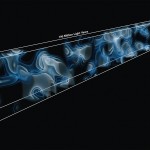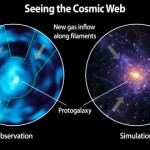W. M. Keck Observatory press release…
W. M. Keck Observatory overnight captured the very first successful science data from its newest, cutting-edge instrument, the Keck Cosmic Web Imager (KCWI).

“I’m thrilled to see this new instrument,” said Keck Observatory Director Hilton Lewis. “It takes years to design and build these very sophisticated instruments. KCWI is a superb example of the application of the most advanced technology to enable the hardest science. I believe it has the potential to transform the science that we do, and continue to keep Keck Observatory right at the forefront of astronomical research.”
KCWI is extremely sensitive, specifically designed to capture high-resolution spectra of ultra-faint celestial bodies with unprecedented detail. It is able to differentiate even the slightest changes in spectral color with a great degree of accuracy.
This powerful capability is key for astronomers because a highly-detailed spectral image allows them to identify a cosmic object’s characteristics, including its temperature, motion, density, mass, distance, chemical composition, and more.
Continue reading “W. M. Keck Observatory Achieves First Light with New Instrument”



